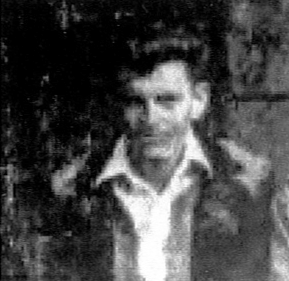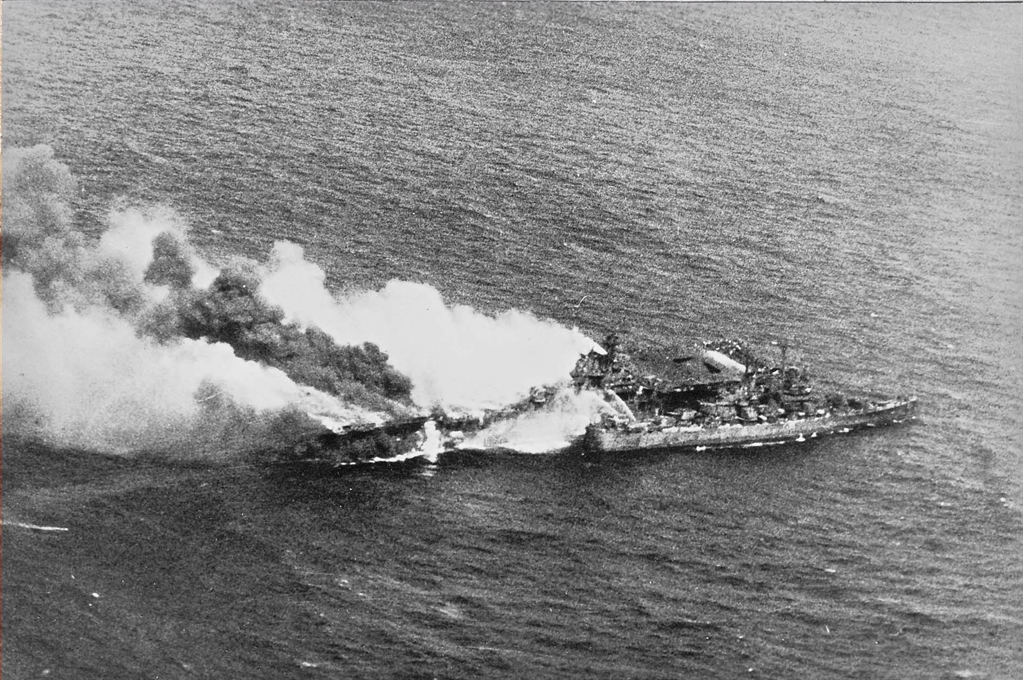
Dr. C.M. Johnston's Project
Discover McMaster's World War II Honour Roll
Richard G. Kelley
 Like Charles (Chuck) Holman, Richard Kelley was an American citizen who attended McMaster University at the same time as he, and subsequently fought in the Second World War. But in one respect he differed from Holman and the others named on the McMaster Honour Roll commemorating those graduates and undergraduates who did not survive that conflict. He was the only naval veteran on that list, having served as a seaman in the United States Navy Reserve (USNR) in the Pacific theatre of operations.
Like Charles (Chuck) Holman, Richard Kelley was an American citizen who attended McMaster University at the same time as he, and subsequently fought in the Second World War. But in one respect he differed from Holman and the others named on the McMaster Honour Roll commemorating those graduates and undergraduates who did not survive that conflict. He was the only naval veteran on that list, having served as a seaman in the United States Navy Reserve (USNR) in the Pacific theatre of operations.
Richard joined an older sister, Dorothy, when he was born in Elmira, New York on 16 October 1915 to Anna Laura (Ballard) Kelley and Enoch James Kelley, a partner in the profitable perfumery firm of Kelley-Whitney Extracts. Richard and Dorothy were at the tender ages of four and eight respectively when their parents became embroiled in acrimonious and protracted divorce proceedings, which eventually played out in 1922. Anna, who had initiated the proceedings, was given custody of the children though Enoch was accorded visitation rights, enabling him to keep in active touch with his offspring.
Years later, in 1932, Anna remarried, thus providing a congenial stepfather for her children in the person of Clarence Hobart (Bricks) Brisco, many years her junior. A long time resident of Corning, New York, he had graduated from the city’s Northside High School and then pursued biblical studies at the Nyack (NY) Missionary College, where his oratorical skills and Christian commitment made him a sought after speaker and lay preacher.
Upon completing his program at Nyack in 1920, Brisco had ventured to the robustly Baptist McMaster University, then located in Toronto. There, exulted the student/faculty magazine, the McMaster University Monthly, he did well academically and starred as an orator and a debater, serving as president of the Debating Club and successfully participating in intercollegiate competition. In short, Bricks Brisco finished up becoming a proverbial “big man on campus”, who would long be remembered at his alma mater.
Following his graduation with a BA in 1924, he had re-settled in hospitable Corning and embarked on a legal career, articling coincidentally in the same firm that had handled the Kelleys’ divorce. He apparently cleared his bar examinations with a flourish and established what soon became a thriving law practice of his own. On New Year’s Day, 1930, less festive than usual perhaps given the somber arrival of the Great Depression, Corning’s mayor appointed a pleased Brisco to the prestigious office of city attorney.
By this time he had already met his future wife, Anna, who had established a prominent business career in her own right, working for some years in the law office that had settled her divorce and taken on Brisco. Moreover she was also markedly active in the Corning Business and Professional Women’s Club and hailed in a Corning newspaper as “one of the outstanding business women of the city”., an accolade bestowed more frequently in the less male-dominated and more free-wheeling society that emerged out of the Great War.
Meanwhile Richard Kelley’s education was not neglected in these heady times. His high school instruction was provided at the well attended Corning Free Academy. After graduating and with the help and encouragement of his parents, he proceeded in September 1934 to Purdue University in Lafayette, Indiana. There he suffered through a mostly unsuccessful academic year, at which point a concerned Clarence Brisco intervened and arranged for his stepson’s admission to his own alma mater, McMaster University.
Clearly the name of alumnus Brisco counted for a good deal at the Baptist institution, particularly in the offices of George Henry, the Bursar, and Elven Bengough, the Registrar, whose solicitude for students or would-be students was legion. Following an exchange of letters with the persuasive Brisco, Bengough and his McMaster colleagues overlooked Richard’s inauspicious Purdue experience and admitted him on the grounds that he had at least been accepted there and merited a second chance to snare the academic brass ring.
The upshot was his admission to McMaster on 23 September 1935 and his registration in Year I of the General Course. He was also assigned a room in Edwards Hall, the men’s brick tudor residence where his path may well have crossed that of fellow resident and American, Chuck Holman. There is no way of knowing whether Richard attended the introductory addresses for freshmen, by which the Registrar set great store. It seems that Richard did not consider himself a freshman anyway by virtue of his year at Purdue. He made the point clear by appearing in the sophomore group picture rather than the freshman one in the yearbook, the Marmor.
In the following spring, shortly after the close of the academic session, a gratified Brisco wrote Bengough:
Richard … has returned home and is looking fine. The training he has received at McMaster has done him much good. His mother has noticed a marked improvement in his poise, conversation and in his general appearance. I feel very much encouraged. He is beginning now to show some signs of marked development… His mother and I are willing to gamble with him, irrespective of what his marks may be. It is the thought of his mother and me that we would like to have him switch the course and take the history and political economy course. I may be able to work him into law….
Brisco added for good measure, that his stepson “greatly admires Professor Kenneth Taylor”, the Dean and political economist. “I know,” he continued, “when he gets under the wholesome influence of Dr. [Chester] New he cannot help but be profited.” New, the acclaimed biographer, and Taylor, the accomplished economist, would have figured largely in Richard’s life had he gone on to register in the History and Political Economy course that as the interested Brisco well knew, often served as a springboard to a possible law degree.
Brisco’s high hopes for Richard, however, were dashed when the year’s examination results were announced. Whatever panache Richard acquired at McMaster his academic performance by contrast was less than lackluster. Failing grades in two of his major courses ruled out a history and political economy future and his preparation for the law. Instead he was regretfully advised that he would have to repeat his year, for him a dismal option he had no intention of taking up, a decision the understandably disappointed Briscos had to accept.
Leaving McMaster and academe behind, Richard rejected the professional life his parents had sought for him and set out to qualify for a productive and rewarding trade. To that end and with his parents’ predictable financial backing, he enrolled in a three-year program at the Bliss Electrical School in Washington DC. Modestly launched in 1893, it had grown to prestigious proportions as an electrical engineering institution by the time Richard arrived on its doorstep. In 1941, after passing the Bliss course, he secured a job in his home town, joining the electrical engineering department of the Corning Glass Works, one of the city’s principal employers.
Now aged 25 and sorted out economically, Richard proposed marriage to a willing Dorothy Kniffen whom he had been courting for some time. Like him a graduate of the Corning Free Academy, she had then taken a business school course and become a bookkeeper. Before her marriage to Richard she broadened her horizons in 1939 by registering in a beautician’s course at the grandly named Del Kader School of French Beauty Culture located in Elmira. Coincidentally or not, the school’s registrar happened to be none other than Enoch Kelley, whose second wife, Gertrude, had established the enterprise that must have been the talk of the town. Given Enoch’s ongoing concern for his grown children’s welfare, he may have fostered the relationship between his son and Gertrude’s student. Whatever the circumstances, the couple were married in Corning on 10 April 1941 with all their assorted families in attendance. The local newspaper, the Evening Leader, did full justice to the occasion, in the course of which it highlighted Anna (Kelley) Brisco’s business reputation.
Some eight months after the wedding the newlyweds’ world was turned up side down by the Japanese assault on Pearl Harbor, which plunged the United States into the Second World War. Childless married men like Richard Kelley were under US Selective Service regulations initially exempted from the draft. That situation changed, however, when the fighting became more costly in men and resources in the brutally expanding conflict in the Pacific. As a result, men in Richard’s category were now called up to serve. Accordingly he joined other would be recruits from the Corning area selected for the various service branches: Army, Navy, and Marines.
Hitherto land-bound Richard was, along with 25 others, assigned to the Navy and after being pronounced fit officially inducted in Buffalo NY on 25 September 1943. This information, gleamed from newspaper accounts, had to pinch hit for Richard’s service record entries, which fell victim to a repository fire in St. Louis MO some years ago. In any case his induction was followed by a week’s furlough, a kind of embarkation leave for paying a farewell visit to his wife and family. According to the Corning New York Leader, after the furlough expired he and the other Navy recruits, part of Corning’s 41st contingent, were ordered to report for duty on 9 October 1943. The newspaper did them proud, publishing their pictures under the exuberant headline, “THEY’LL PUT THE X ON THE AXIS”, the alliance that bound together the country’s foes, Nazi Germany, Fascist Italy, and Imperial Japan.
The duty allotted Richard eventually landed him in the middle of the Pacific campaign aboard the storied USS Franklin (“Big Ben”). Commissioned some three months after Richard’s induction, it was an Essex-class aircraft carrier which ultimately won four battle stars in a violent career that extended from the Marianas to Okinawa and the Japanese homeland, not to mention a series of island targets in between. The Franklin in the later stages of the campaign also managed to survive suicidal Kamikaze attacks.
Early on the morning of 19th March 1945, Electrician’s Mate 3rd Class Richard Kelley was likely at breakfast aboard the Franklin as she patrolled a scant eighty miles off the Japanese coast, a record-breaking intrusion. But while so engaged luck suddenly ran out for this veritable workhorse of a ship. A lone Japanese dive bomber broke through a cloud screen above her and with a determined pilot at the controls released two well directed 500 lb. bombs. They had a devastating effect. One struck and exploded on the flight deck, the other plummeted through to the hangar deck below before exploding, blowing up fuelled aircraft, causing further deadly destruction and raging gasoline-fed fires.

Though horrendously damaged the durable Franklin managed to stay afloat. Even more horrendous was the loss of life aboard her. Some seven hundred of the crew were killed in the attack and well over two hundred wounded. Survivors talked of “grotesque scenes” and a “living hell”, one seaman gulping whiskey as he swept bloody body parts from the battered flight deck. Among the many fatalities was former McMaster undergraduate, Richard Kelley. For her part the stricken Franklin was able to limp back to port for a complete restoration, though she saw no further action in the war. After war’s end, this once honoured ship, Richard’s wartime home away from home, ended up ignominiously in a West Coast scrap yard, despite efforts to have her enshrined as a memorial.
In early 1946 the vigilant McMaster Alumni News gathered information on Richard’s death and posted his obituary. Among other things, it commented that,
“he will be mourned by many graduates who knew him and others who were friends of his stepfather, Clarence Brisco …..”
The grief-stricken Brisco had also done his bit in the war, having served as a captain in the US Army, at one point stationed in India.
Richard Gordon Kelley is commemorated in Honolulu on the Punchbowl Memorial Wall, the site of an extinct volcanic crater of that name, which in 1949 was dedicated as the National Memorial of the Pacific. (See Capt. William T. Rice, The Pearl Harbor Story [Hawaii, Hagadone Printing, n.d.], p. 48.)
C.M. Johnston & Lorna Johnston
NOTE: Readers who may have additional or corrective information are requested to get in touch with the authors: cjohnson12@cogeco.ca or
905 648-6272. All submissions will be gratefully acknowledged.
**********************************************
ACKNOWLEDGMENTS: The bulk of the research was kindly undertaken by the ever helpful Linda Payne. She supplied vital US Census and NY State Census data and an assortment of newspaper accounts and leads. (See SOURCES below.) Also helpful were Adam McCulloch, who presides over the Canadian Baptist Archives, and Sheila Turcon at Special Collections, McMaster University Library.
SOURCES: As noted, Richard Kelley’s USNR service record has not survived, nor was there any known wartime correspondence and diaries.
US Censuses (ancestry.com) 1900, 1910, 1920, 1930, 1940; NY State Censuses, 1915, 1925,
All newspaper articles are from http://fultonhistory.com : Elmira Daily Gazette and Free Press, 7 Oct. 1901, p.8, Elmira NY Morning Telegram, 31 Oct. 1915 (“SOCIETY”), 13 Feb., 10 April 1921, Evening Leader, Corning NY, 31 Oct., 1 Nov. 1927, 29 Feb. 1932, p. 7, 7 Sept. 1935, p. 12, 10 April 1941, (“Marriages”), Corning NY Leader, 10 Aug. 1943, p. 10, 25 Sept. 1943, 9 Oct. 1943, Corning, New York Evening Leader, 19 May 1945, p. 10; US City Directories, 1821-1989: Elmira, NY City Directory, 1937, p. 235, 1939, p.255.
McMaster Divinity College/Canadian Baptist Archives: Student File 5669 and Biographical File, Richard G. Kelley; Student File and Biographical File,
Clarence H. Brisco: McMaster University Monthly. May 1924, grade reports, newspaper clippings, correspondence; McMaster University Library/Special Collections: Marmor 1936, pp.45, 61; McMaster Alumni News, 22 Feb. 1945, p. 6, 19 Jan. 1946, p. 7.
Internet links: Bliss Electrical School, Washington DC (1893-1950), Speech by Professor Bliss, 1955; USS Franklin (for memoirs, graphic footage, and bibliography).